![]()
![]()
![]()
Use LEFT and RIGHT arrow keys to navigate between flashcards;
Use UP and DOWN arrow keys to flip the card;
H to show hint;
A reads text to speech;
134 Cards in this Set
- Front
- Back
- 3rd side (hint)
|
SV CO Preload Afterload EF |

|
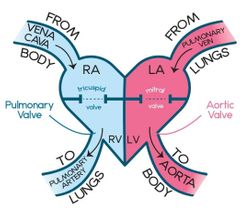
•Bicuspid & Tricuspid:atrioventricular valves that close at the beginning of ventricular contraction •Pulmonic semilunar & Aortic semilunar: semilunar valves • Epicardium: outermost layer of the heart. • Myocardium: middle layer of the heart, the contracting muscle. • Endocardium: innermost layer of the heart, lines the inner chambers & valves. |
|
|
Pulmonary circulation Systemic circulation Coronary circulation |
Pulmonary circulation: Deoxygenated blood is transported through the right side of the heart and into the lungs Systemic circulation: The movement of oxygen rich blood from the heart to the rest of the body through the arteries, and back to the heart via the veins.Then back to the left side of the heart Coronary circulation: Supplies oxygen rich blood to the myocardium (heart muscle) via the coronary arteries, deoxygenated blood is returned to right atrium via coronary veins |
|
|
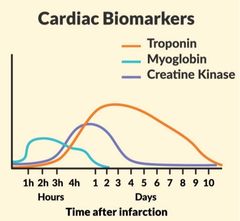
cardiac enzymes |
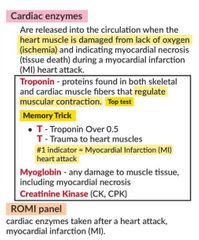
ROMI panel: reevaluated every 6-8 hours all three are tracked to evaluate the severity of MI basically to see if the heart is getting worse/better |
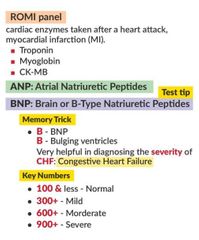
▪︎troponin: 3-4 h after MI releaseremain detectable up to 10 days ▪︎myoglobin(benefit): 30 min after MI(early detection but it doesn't always mean MI) ▪︎CK-MB: 3-4 h after MIremain elevated 3-4 dayshelpful to detect reinfarction ▪︎ANP: response to the increase stretching of atrial wall due to increase atrial blood volume ▪︎BNP: gets released by heart & blood vessels as there's increased pressure within heart, BNP increases to open up blood vessels in body and take pressure off heart |
|
|
natriuretic peptide |
•︎ hormones secreted by cells of heart chambers due to damage to heart & they're used to determine if heart chambers is stretched out from highBP • 2 types of natriuretic peptides: ▪︎BNP Brain Natriuretic Peptide: shows deterioration of ventricles biggest indicator of HF BNP over 100 pg/ml= Heart Failure less than 100 is normal increased BNP: high sodium diet, sedentary life style (no exercise), high cholesterol diet, renal failure ▪︎ANP Atrial Natriuretic Peptide : in atriums ANP affects nephrones & creat opposit affect of aldosterone in response to increased Blood volume that stretches out & damages heart tissue because aldosterone hlods sodium & fluid in body (ANP blocks reabsorption of sodium in kidneys & increase filtration) incresed ANP: acute HF, SVT, Hyperthyroidism, small cell lung cancer decreased ANP: Chronic HF, Hypothyroidism |
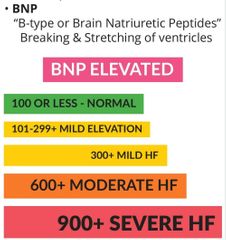
|
|
|
ACS |
“acute coronary syndrome” Angina - Stable “Safer”- relieved w/rest Angina - Unstable “Unsafe” -Unrelieved |
|
|
|
Stable angina |

Stable angina is chest pain induced by any physical activity like: walking up stairs, working in the yard or even from sex. Anything that causes exertion! (classic exertional Angina) There is less oxygen being delivered to the heart muscles during the physical excretion resulting in pain that stops when the physical activity stops. |
|
|
|
unstable angina |
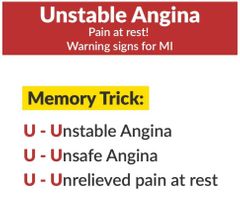
Pain at rest! This is a warning sign for an MI (heart attack). It is the more severe angina as it means more severe narrowing of the coronary arteries resulting in less oxygen to the heart muscles. |
|
|
|
Prinzmetal |
variant angina Coronary vasospasm Sudden spasm, temporary narrowing or tightening in a coronary artery.the heart doesn't get enough blood & oxygen - resulting in pain Short-term factors that cause vasoconstriction: - Stress - Stimulants (caffeine, meth, cocaine) - Smoking, cold weather NOT from long-term narrowing of the arteries from plaque buildup, which is more typical in stable & unstable angina. |
|
|
|
angina pharmacology |

|
|
|
|
stable angina nitroglycerin |
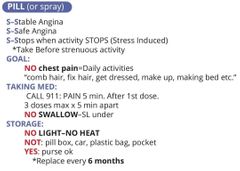
|

|
|
|
unstable angina nitroglycerin |
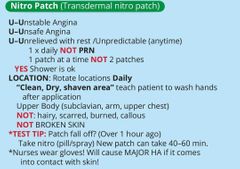
|

|
|
|
MI |
Myocardial Infarction (MI) the heart muscles DIE “necrosis” from lack of oxygen. This occurs when there is a blockage of the coronary arteries. causes: SODDA S– Stress, Smoking, Stimulants (caffeine, amphetamines) O–Obesity (BMI over 25) D–Diabetes & HTN (over 140/90) D–Diet (high cholesterol) animal fats A–African American males & Age (over 50) *Men more than women |
heart cells dies & release troponin #1indicator of MI |
|
|
Ischemic heart disease progression |
CAM C–CAD “coronary artery disease” A–ACS “acute coronary syndrome” Angina - Stable “Safer” relieved w/rest Angina - Unstable“Unsafe”Unrelieved M–MI (heart die) |
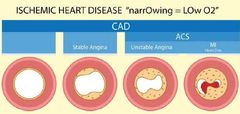
|
|
|
MI signs & symptoms |
PAIN: Jaw, left arm, mid back/shoulder pain, heartburn (epigastric), Substernal chest pain, Crushing or Radiating Key words = priority:“Sudden” “Crushing” “radiating”"Heavy Pressure" SOB “dyspnea” “labored breathing” NAUSEA Vomiting “Abdominal pain” SWEATING “Diaphoresis” PALE COOL SKIN “dusky” ANXIETY |
silent MI: diabetic patients |
|
|
MI diagnostics |
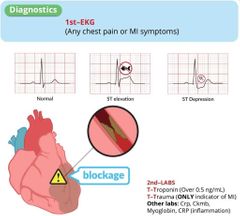
NCLEX: ST Elevation & positive troponin over 0.5 indicates MI any new chest pain always require an ECG first ST ELEVATION = No O2 / hyperkalemia ST DEPRESSION = Low O2 always confirm with troponin labs when heart muscle cells die, they release troponin & K (hyperkalemia) other labs CK, Ckmb, CRP |
|
|
|
MI Treatment |
(+) Positive Troponin = Heart Attack (MI) PRIORITY: REMOVE THE CLOT! the goal is to unclog the coronary artery within 45mins patients are taken to cath lab immediately to locate & fix the blockages we can also use thrombolytics (clot busters) if surgery is not immediately available TPA / Streptokinase they are not for first line therapy since they cause massive bleeding & should be given within 2-6 hours from initial MI |
|
|
|
MI treatment: ABC of MI surgery |
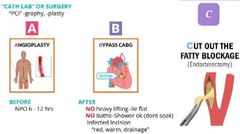
|
(+) Positive Troponin = Heart Attack (MI) PRIORITY: REMOVE THE CLOT! within 45 minutes |
|
|
MI treatment clot busters |
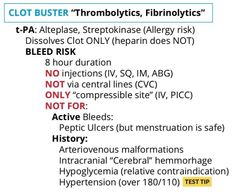
|
(+) Positive Troponin = Heart Attack (MI) PRIORITY: REMOVE THE CLOT! |
|
|
STRESS TEST (-) Negative Troponin |
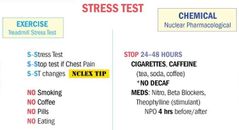
• Non MI (non priority) • Spot the Narrowing TREADMILL STRESS TEST STOP test: chest pain & ST elevation NUCLEAR PHARMACOLOGICAL STRESS TEST 24–48 hours BEFORE NO Cigarettes, Caffeine (tea, soda, coffee) *NO DECAF NO Meds: Nitro, Beta Blocker, Theophylline (stimulant) NPO (nothing oral) 4 hrs before/after |
|
|
|
اقدامات اولیه for any acute chest pain |
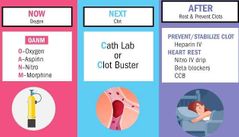
|
we don't know until we take an ECG & troponin |
|
|
MI treatment |

|

oxygen for perfusion Aspirin prevent platelets from sticking together Nitro dilate coronary arteries Morphine relax the heart & decrease the work load |
|
|
Nitro |

in chronic angina patients if there's pain 5 minutes after the first dose of Nitro call 911 |
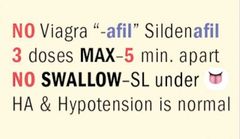
HA = Headache |
|
|
Morphine |
any pain after morphine indicates MI more pain = more tissue death |
|
|
|
cath lab |

angioplasty means baloon or stent replacement & patients are usually awake & not under general anesthesia before angioplasty NPO 6-12 hours after angioplasty lie flat for several hours & encourage to drink to dilute contrast dye bypass = open heart surgery NO Heavy Lifting NO baths or soaking the wound but shower is ok Prevent infection, monitor for redness, warmth, swelling & drainage report to HCP immediately |
|
|
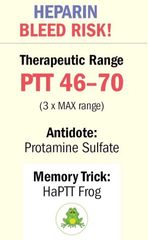
|
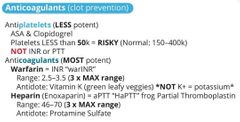
|
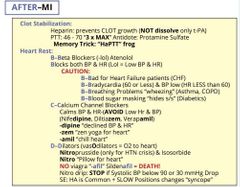
|
|
|
bleed risk patient education |
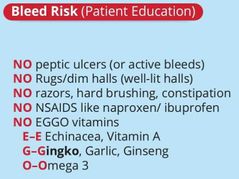
|
|
|
|
complications after MI |
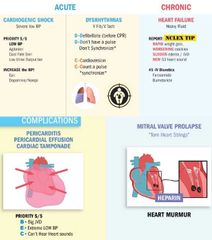
|
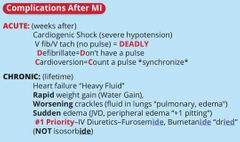
|
|
|
MI patient education |

|
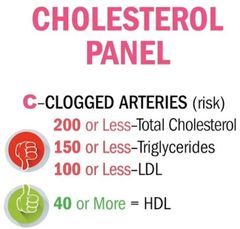
daily weight any rapid weight gain or new edema or dyspnea (orthopnea) call HCP because these are early signs of heart failure high sodium food: chips,dressings,meets,catchup, cheese, anything that comes in a package |
|
|
MI TREATMENT |

|
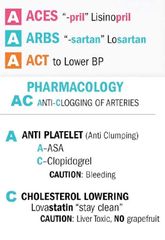
|
|
|
congestive hear failure |
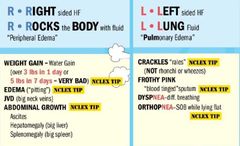
|
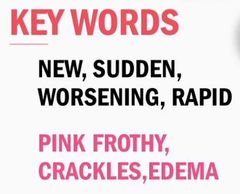
• HF - Heart Failure (failure to pump blood forward) • HF - Heavy Fluid (backs up in lungs / body) Weight Gain = Water Gain Rales that don't clear with a cough JVD: jugular vein distention |
|
|
pulmonary edema priority interventions |
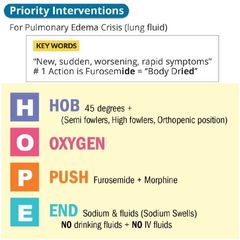
|
|
|
|
4 common NCLEX Question for worsening HF |
1.how does the nurse know if the treatment is successful? clearer lung sounds with decreased HR 2.always question: any order that wants to give fluids even maintenance IV fluids 3.when you transferring a heart failure patient to another unit: always reassess heart & lung sounds any patient transferring to another floor "worsening crackles in lungs" 4. sodium: swells the body nothing from package like chips, package foods, salad dressing, sauce, meet, cheese nothing OTC cold/flu medicine, Tylenol (acetaminophen), antiacid |
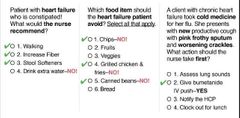
|
|
|
HF & Kidneys |
due to impaired pumping ability we have less cardiac output as a result the kidneys get less blood flow & falsely think BP is low or blood volume is low so mistakenly increases the already high blood volume by 1.stimulating SNS to increase the HR & constrict the blood vessels 2. initiating the RAAS (Renin Angiotensin Aldosterone System) which retains fluids by locking kidneys & constricting the blood vessels now we have 2 problems: an already weak pump with increasingly high blood volume |
|
|
|
Aldosterone in RAAS Renin Angiotensin Aldosterone System |
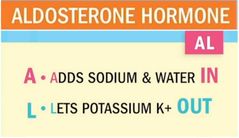
drugs that blocks/cut the communication line to aldosterone -pril (ACE) Lisinopril -sartan (ARBs) Losartan -actone (Diuretic) Spironolactone all these drugs increase potassium >5 |
|
|
|
HF diagnostics test |
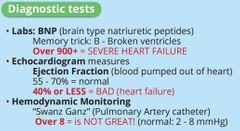
|
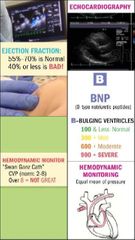
|
|
|
HF nursing care & interventions |
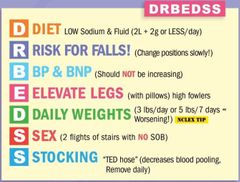
|
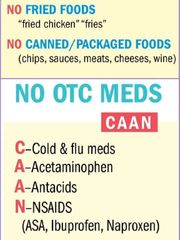
|
|
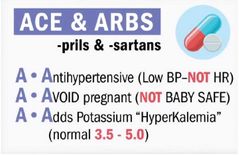
ACE & ARBS |

ARBs = Angiotensin Receptor Blockers if the HR is low ACE & ARBs are the best choices because they act to lower BP only (not HR) Both ACE & ARBs either inhibit or block the RAAS which retains fluid Aldosterone: A: Adds sodium & water in L: Lets potassium out side effect: retain potassium in any potassium Imbalance always the first action by the nurse is cardiac monitoring |
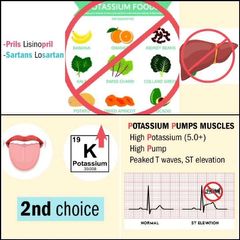
|
|
|
Calcium Chanel Blocker |
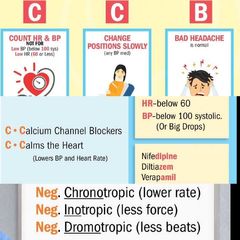
|
|
|
|
DIGOXIN |
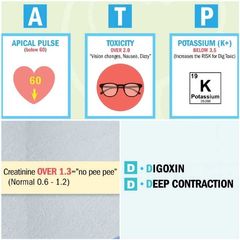
|
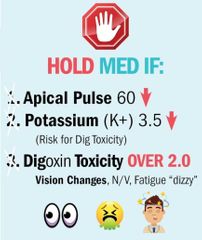
which patient is most at risk for digoxin toxicity? patients on potassium wasting diuretics -ide or kidney failure with creatinine>1.3 Low potassium increases the risk for toxicity (digoxin can NOT cause hypokalemia, so you do NOT need eat more green leafy veggies or melons like when we taking Thiazide or loop diuretics that waste potassium) positive Inotropic = deep contraction negative chronotropic = decrease HR monitor elderly & Renal failure patients closely because of digoxin toxicity
|
|
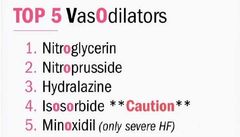
|

|
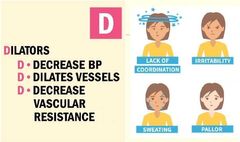
commonly given for chest pain but also works for HF patients to lower BP lower pre & Afterload which lowers BP |
|
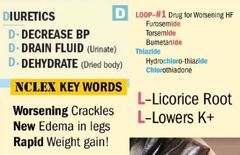
diuretic |
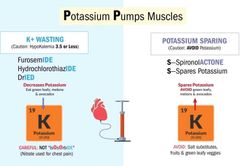
|
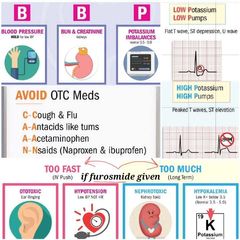
blocks reabsorption of sodium Spironolactone like -pril & -sartan Spares potassium instead of blocking RAAS blocks aldosterone(salt water hormone) directly in any potassium Imbalance always the first action by the nurse is cardiac monitoring Diuretics •morning NOT at night •slow position changes (any BP med) •daily weight (report 2-3 lbs) •sunburn •Low sodium diet (sodium swells) avoid OTC Meds C -Cough & Flu meds A -Antiacids like tums A -Acetaminophen N -NSAIDs (Naproxen & ibuprofen) Furosemide is #1 Drug for worsening HF but if given too fast ..... |
|

cardiomyopathy |
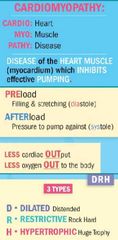
All problems lead to LESS cardiac output meaning LESS O2-rich blood OUT to the body. • Low oxygen • Restlessness, agitation, altered LOC • syncope, dizzy + fatigue • Heart failure signs • Left-sided = Lung fluid • Right-sided = Rocks the body with fluid (edema, ascites, JVD) |
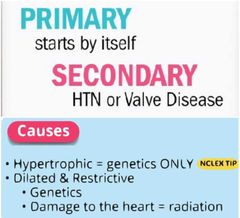
|
|
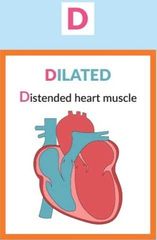
|
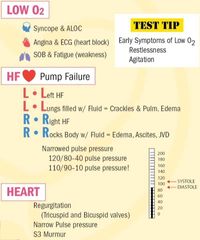
Dilated Cardiomyopathy: Think “Distended heart muscles” ,clients present with fibrosis (stiff hard muscles) of the myocardium & endocardium, dilated chambers, making it hard for the heart to pump out oxygen-rich blood. so the body thinks we have low pressure so attempts to •increase BP by stimulating SNS to increase HR •increase BP by stimulating kidneys to initiate RAAS Dilated cardiomyopathy s/s : • S3 murmur • Cardiomegaly (dilated heart) |
All problems lead to LESS cardiac output meaning LESS O2-rich blood OUT to the body. • Low oxygen • Restlessness, agitation, altered LOC • syncope, dizzy + fatigue • Heart failure signs • Left-sided = Lung fluid • Right-sided = Rocks the body with fluid (edema, ascites, JVD) |
|
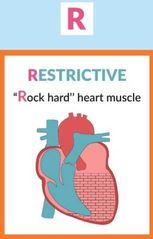
|
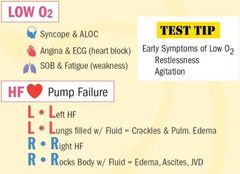
• Restrictive Cardiomyopathy: Think “Rockhard heart muscles”, so the heart cannot RE-fill with REstric-tive cardiomyopathy, emboli (blood clots) are common. Restrictive Cardiomyopathy • (same general low oxygen & HF) |
All problems lead to LESS cardiac output meaning LESS O2-rich blood OUT to the body. • Low oxygen • Restlessness, agitation, altered LOC • syncope, dizzy + fatigue • Heart failure signs • Left-sided = Lung fluid • Right-sided = Rocks the body with fluid (edema, ascites, JVD) |
|
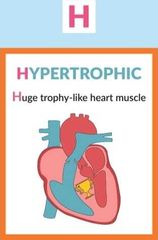
most important most deadly |
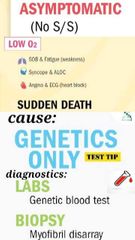
• Hypertrophic Cardiomyopathy: Think “Huge Trophy-like heart muscles” in the middle septum which can obstruct the aorta blocking all oxygenated blood out to the body - very deadly! Obstructive = blocks the Aortic valve Non-obstructive = does not block Hypertrophic Cardiomyopathy • Typically asymptomatic (no s/s) until heavy exercise & then the child DIES! treatment: surgery B: Beta Blocker (Block Beats) AtenoLOL C: Calcium Channel Blocker (Calm Heart) Nifedipine, Diltiazem never give 3D's NO! NO! NO! D-Dilators (Nitro) D-Digoxin D-Diuretics AVOID! Deadly •Heavy Lifting (bearing down to poop) •Burst of activity (sprints) •Sudden Position changes |

All problems lead to LESS cardiac output meaning LESS O2-rich blood OUT to the body. • Low oxygen • Restlessness, agitation, altered LOC • syncope, dizzy + fatigue • Heart failure signs • Left-sided = Lung fluid • Right-sided = Rocks the body with fluid (edema, ascites, JVD) |
|
|
Cardiomyopathy diagnostics |
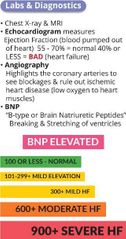
|
in restrictive cardiomyopathy the heart is not enlarged (like dilated Cardiomyopathy) & EF is normal & usually treatment is heart transplant |
|
|
Cardiomyopathy pharmacology |
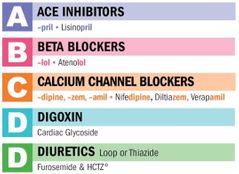
|
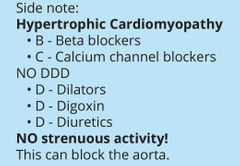
these drugs calm ❤ & Low BP / HR goal: increase CO to increase O2 |
|
|
Cardiomyopathy treatment |
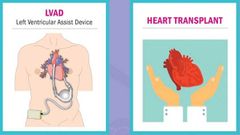
|
|
|
|
Cardiomyopathy patient education |
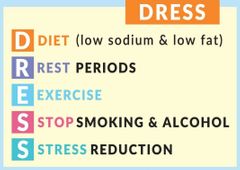
|
|
|
|
cardiac tamponade |

|
|
|
|
cardiac tamponade signs & symptoms |
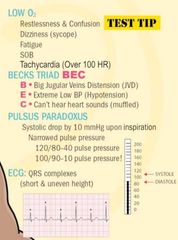
|
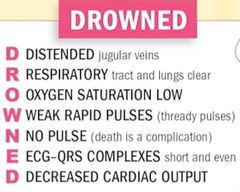
|
|
|
cardiac tamponade causes |
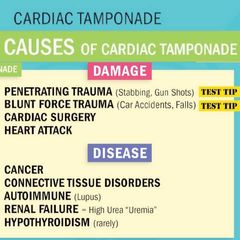
|
ACUTE: TRAUMA: (Stabbing or MVA) CHRONIC: Pericarditis |
|
|
cardiac tamponade diagnostic tests |
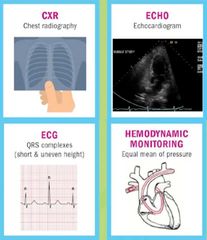
|
|
|
|
cardiac tamponade treatment |
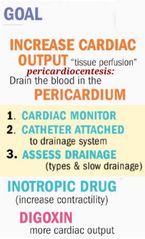
|
|
|
|
cardiac tamponade wrap up |
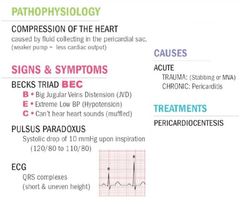
|
|
|
|
endocarditis |
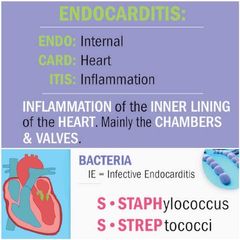
|
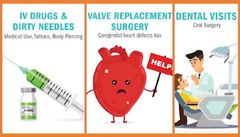
• Infective = bacteria (mold on heart valves) • Noninfective = No bacteria (only inflammation) Heart valves can’t close fully Less cardiac output = Less oxygen OUT |
|
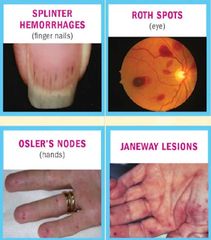
endocarditis signs & symptoms |
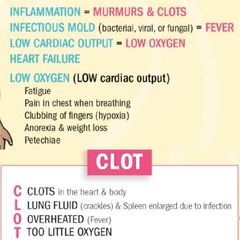
splenomegalia since the spleen is the house for WBCs |
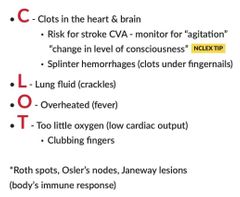
|
|
|
4 classic signs of endocarditis |
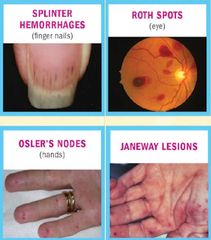
Splinter Hemorrhage little clots of mole that breaks off heart valves & end up under finger nail beds Roth Spots in the eye known as Retinal Hemorrhages Olser's Nodes painful red raised Lesions that found on the hands & feet Janeway Lesions flat circular Lesions that found on the palms & soles of the feet |
|
|
|
most deadly complication of endocarditis |
Risk for stroke or embolic CVA monitor for : “agitation” “change in LOC” first signs of low o2 to the brain: confusion, agitation, slurred speech,weakness, facial drooping |
|
|
|
causes of endocarditis |
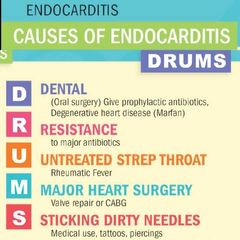
|
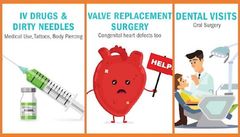
|
|
|
diagnostic tests for infective endocarditis |
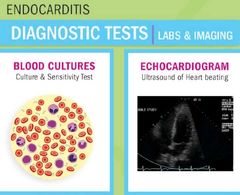
|
|
|
|
treatment for infective endocarditis • Antibiotics • Valve repair or replacement |
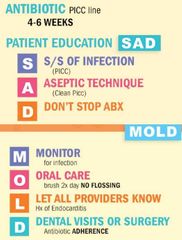
IV antibiotics last for 4-6 weeks & they can destroy small peripheral vessels so they should be given through central line |
never withhold antibiotic therapy while waiting for cultural results even though it might be a fungal infection |
|
|
central venous catheter |

|
|
|
|
endocarditis ABX |
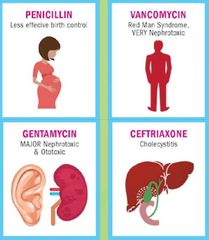
penicillin is the antibiotic of choice but a lot of patients have allergy or some type of resistance to penicillin family & can cause less effective birth control & cause accidental pregnancy (deactivates the pill,use alternative form of birth control) vancomycin if it given too fast or first dose, massive flushing of skin red rashes or hives usually around neck & chest, STOP the infusion & then assess the patient airway Ceftriaxone radiating shoulder pain, NO alcohol |
|
|
|
Pericarditis |
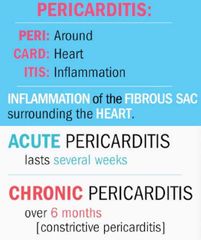
Inflammation OUTside the heart (heart gets compressed & can’t pump) Less cardiac OUTput = Less oxygen OUT |
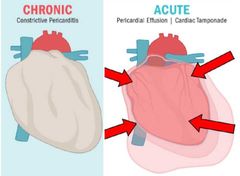
|
|
|
Pericarditis causes |
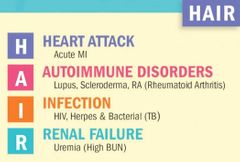
50-80% is unknown (idiopathic) |

|
|
|
pericarditis signs & symptoms |
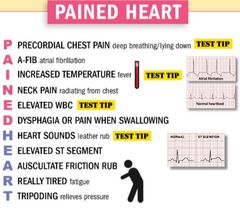
monitor for: •muffled heart sounds •pulsus paradoxes Drop in Systolic BP by 10 mmHg precordial chest pain from friction rub that radiates to the left side of the neck, shoulder, back worsens with deep breathing/lying supine gets better when sitting up/leaning forward /tripoding • Elevated WBC (over 10,000) • C-reactive protein |
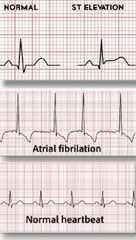
|
|
|
pericarditis diagnostics |
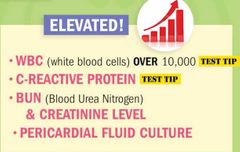
|
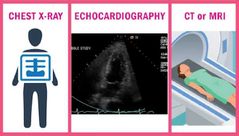
|
|
|
pericarditis treatment |
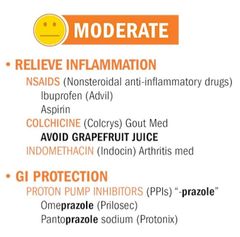
|
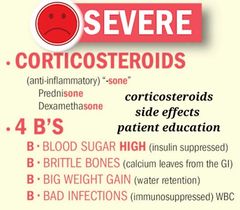
•surgery: pericardiocentesis it's important to have NGT placed prior to pericardiocentesis so we could decompress the stomach & prevent puncture •never stop Prednisone abruptly taper off abrupt stop = Adrenal Crisis |
|
|
Pericarditis vs Endocarditis |
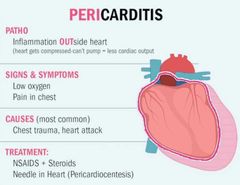
|
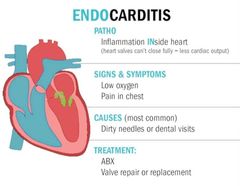
|
|
|
PVD: Peripheral Vascular Disease types & signs & symptoms |
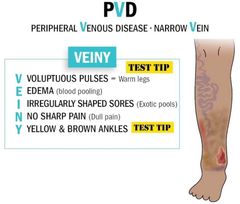
Peripheral Vascular Disease scarring & narrowing of the peripheral blood vessels (veins & arteries) like those in the legs & arms. making them small & stiff become very difficult for blood to get through to the extremities. 2 different conditions for PVD • PVD: Peripheral Venous Disease - narrowed Veins • PAD: Peripheral Artery Disease - narrowed Arteries |

|
|
|
PVD vs PAD |
PAD = problem pushing oxygen rich blood Away from the heart. Oxygen can’t get to legs! WORSE PROBLEM leading to: - Ischemia (low oxygen) - Necrosis (tissue death) PVD = problem Vacuuming deoxygenated blood back to the heart! Blood begins to pool in the legs manifesting as Varicose Veins |

|
|
|
intermittent Claudication |
it's intermittent calf pain in PAD |
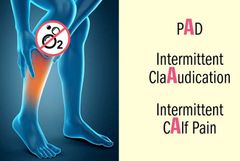
|
|
|
6 P's = O2 assessment |

|
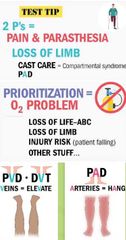
|
|
|
Peripheral Vascular Disease nursing interventions |
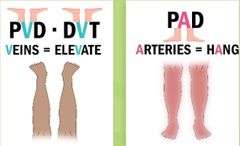
|
|
|
|
Peripheral Vascular Disease causes |

|
|
|

Atherosclerosis |

|
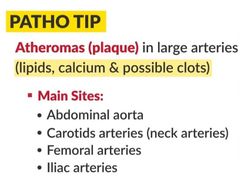
|
|
|
Peripheral Vascular Disease treatment |
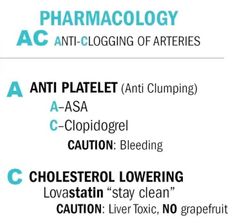
|
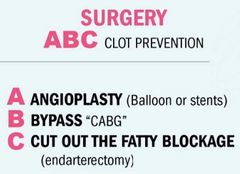
|
|
|
Peripheral Vascular Disease Patient Education |
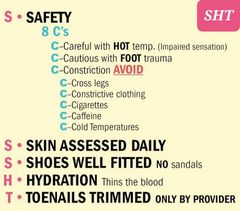
limited standing compression socks |
|
|
|
DVT causes |
Deep Vein Thrombosis smoking, diabetes (uncontrolled), HTN (over 140/90) |
|
|
|
causes of DVT |
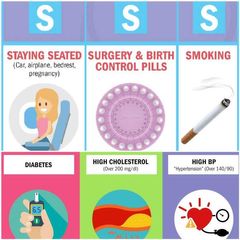
|
|
|
|
DVT diagnostics |
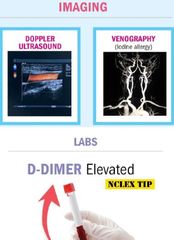
|
D-Dimer measures that actual clot break down in the body that happens all the time but elevated d-dimer shows elevated clot break down |
|
|
DVT treatment |
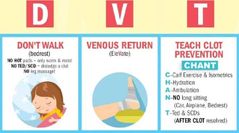
GOAL: preventing the dislodgment of the blood clot (prevent PE) TED hose : Compression stockings SCD : Sequential Compression Device |
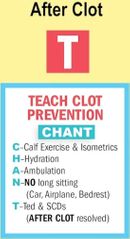
|
|
|
DVT Treatment During Blood Clot |

|
|
|
|
once DVT is resolved prevent a DVT after surgery like knee/hip replacement surgery |
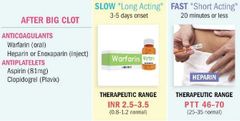
|
|
|
|
DVT Nursing Interventions |

|
|
|
|
4 rules of potassium |
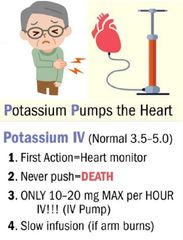
|
|
|
|
4 stages of shock 5 types of shock |
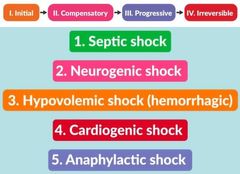
|
Shock: decreased tissue perfusion eventually leading to organ failure and death |
|
|
Initial |
There is too little oxygen in the blood to feed the organs, resulting in anaerobic metabolism, meaning metabolism without oxygen - BUT s/s are absent in this stage |
|
|
|
Compensatory |
The body is trying to compensate for the LOW oxygen, So the heart will pump faster (tachycardia) & RR increases to get more oxygen (tachypnea) body compensates with the sympathetic nervous system to speed up the vital signs & renin-angiotensin activation to maintain BP and oxygenation to keep the organs perfused |
|
|
|
Progressive |
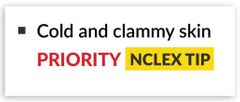
|
|
|
|
Irreversible |
Death is imminent |
imminent: قریب الوقوع |
|
|
Septic Shock |
a septic widespread bloodborne infection that overwhelms the body typically caused by a bacterial infection like Pneumonia or UTI or kidney infection that gets worse. A systemic cytokine release inside the bloodstream causes extreme vasodilation & fluid leakage from capillaries |
|
|
|
Septic Shock Signs & Symptoms |
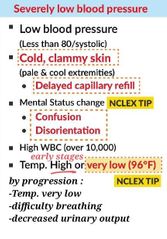
|
MUST report to HCP immediately EMERGENCY treatment is necessary |
|
|
Septic Shock treatment |
Emergency treatment may include supplemental oxygen, intravenous fluids, antibiotics, and other medications. |
|
|
|
Neurogenic shock |
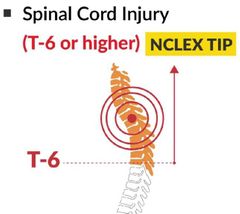
The Autonomic nervous system is damaged resulting in the blockage of the sympathetic nervous system which is supposed to speed up the vitals & vasoconstriction. Only the parasympathetic system is intact - which puts the breaks on the vitals causing widespread vasodilation & hypotension naturally, we see low & slow vital signs like HR & BP. Vasodilation causes decreased blood flow BACK to the heart leads to decreased cardiac OUTput & this leads to poor tissue perfusion from the lack of oxygen & impaired cell metabolism resulting in organ failure & death. |
|
|
|
Neurogenic shock S/S |
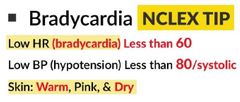
|
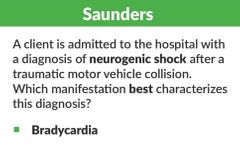
|
|
|
Neurogenic Shock interventions |
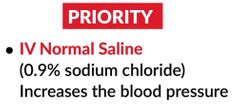
|
|
|
|
Autonomic Dysreflexia a deadly complication for any spinal cord injury above T6 |

severe hypertension that can kill the client |
|
|
|
Hypovolemic shock (hemorrhagic) |
Caused by excessive fluid volume loss through diarrhea, vomiting, or fluid shifts as in burn patients & from bleeding (hemorrhage) from trauma like a gunshot or knife injury, or even surgery & GI bleed. |
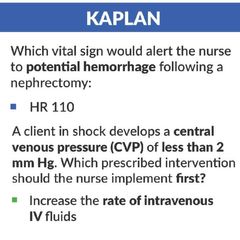
|
|
|
Hypovolemic shock S/S |
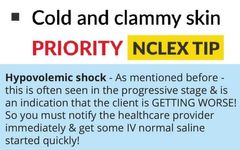
|

4. low urinary output <30ml/hr due to fluid volume loss |
|
|
Hypovolemic shock interventions |
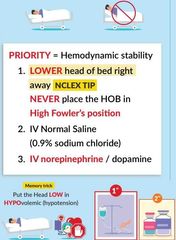
|

|
|
|
Cardiogenic shock |
The heart fails to pump like in heart failure exacerbation or an MI heart attack heart muscles are weak & fail to pump |
|
|
|
A client having a… myocardial infarction based on elevated troponin levels … the nurse should alert the primary health care provider because the vital sign changes … are most consistent with which complication? Refer to the exhibit. |
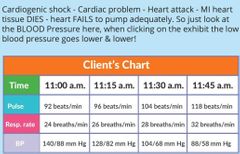
|
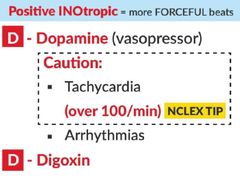
|
|
|
Client with heart failure exacerbation… and suspected state of shock. The nurse knows which intervention is the priority for this client? |
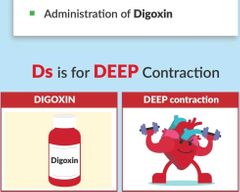
|
|
|
|
Cardiogenic Shock treatment |
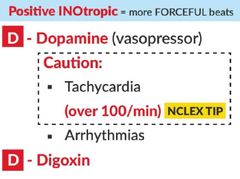
|
|
|
|
Anaphylactic Shock |
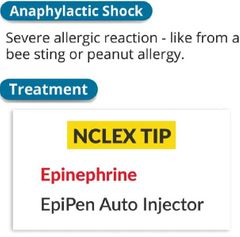
|
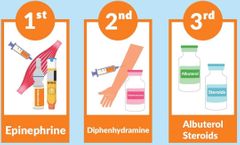
Anaphylactic reaction vs Mild allergic reaction : any allergy that affects the ABC Airway, Breathing, Circulation or even induces hives this is anaphylaxis |
|
|
Epinephrine |
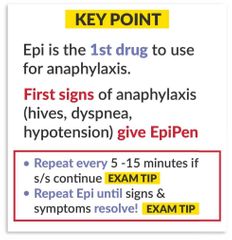
|

|
|
|
Epinephrine Normal side effects |
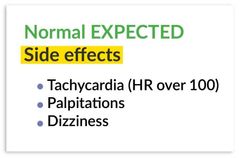
|
|
|

|
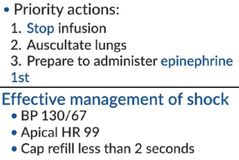
|
|
|
|
HTN |
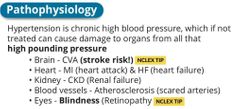
|
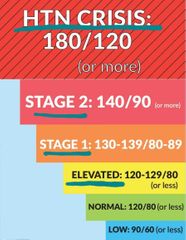
|
|
|
HTN S/S |

|
|
|
|
HTN causes |
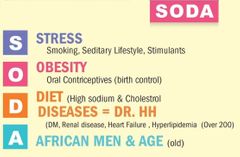
|
|
|
|
HTN Complications |
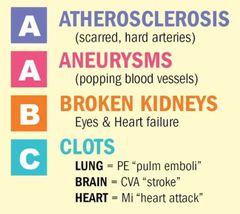
|
|
|
|
Diagnostics Tests |
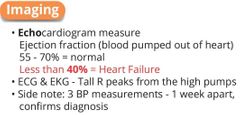
|
|
|
|
HTN Labs |

|

Left ventricle Hypertrophy |
|
|
HTN treatment |
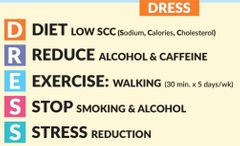
|
|
|
|
HTN pharmacology |
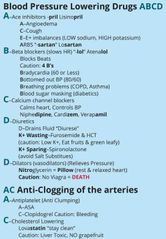
|
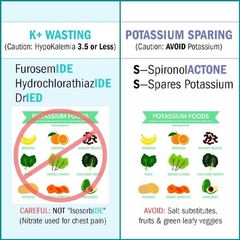
|
|
|
Pacemakers |
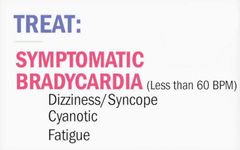
symptoms related to Low O2 |
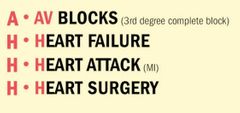
|
|
|
Types of Pacemakers |
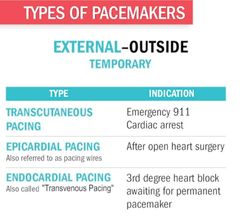
|
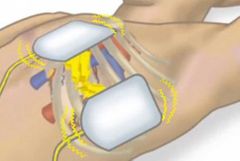
|
|
|
Types & Modes of Permanent Pacemakers |
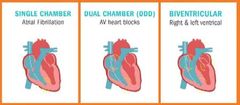
|

|
|
|
post operative Pacemakers interventions & patient education |
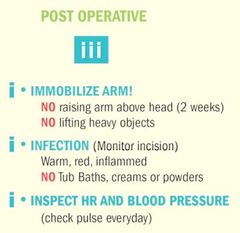
|

|
|
|
can Pacemaker patients use TENS Transcutaneous electrical nerve stimulation (TENS) |

|
|
|
|
Valve disorder |
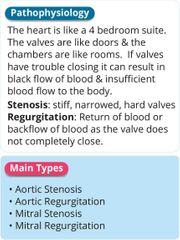
|
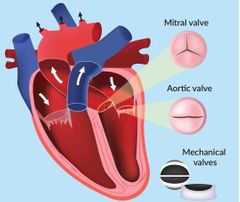
|
|
|
Valve disorder Pharmacology, Surgeries, Patient Education |
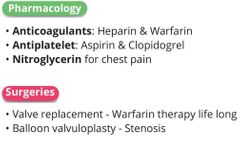
|
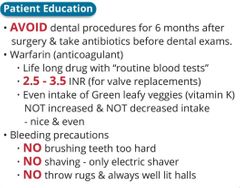
|
|
|
Valve disorder S/S & Causes |
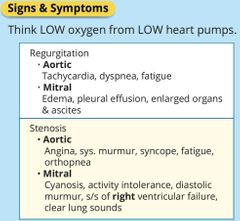
|
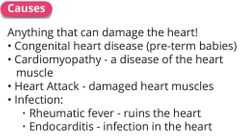
|
|

|

|
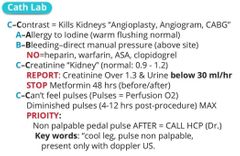
allergy to shellfish isn't using to screen for iodine allergy anymore after:lie flat (supine) & don't cross the legs REPORT over 1.3=Kidney damage/contrast nephropathy urine: 30ml/h or Less avoid renal failure patients STOP Metformin 48 hrs (before/after) cath lab to prevent lactic acidosis & nephropathy Mucomyst (Acetylcysteine) to protect kidneys |
|
|
Discharge teaching |

avoid NSAIDS like Ibuprofen & naproxen can cause increased risk for thrombotic effects |

|
|
|
HF causes & risk factors |

1. Hypertension (high BP) is the #1 risk factor 2. Atrial fibrillation & other dysrhythmias 3. Mitral valve regurgitation 4. Cardiomyopathy right sided HF : COPD, Smoking, obstructive sleep apnea |
fluid fills the lungs causing pressure (pulmonary hypertension) which in result the right side has trouble pumping blood forward so left sided HF commonly causes right sided HF |
|
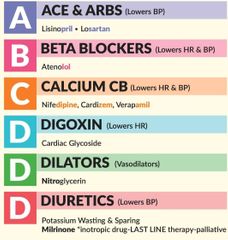
HF pharmacology |
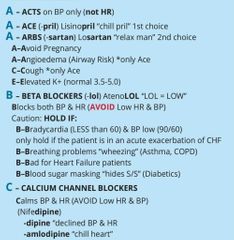
|
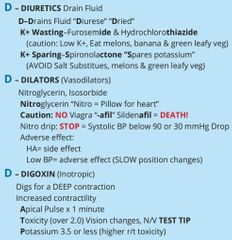
all these drugs drop the BP & take work load off the heart & cause orthostatic hypotension except DIGOXIN since it doesn't affect BP = Change positions slowly |
|
|
Cardiomyopathy signs & symptoms |
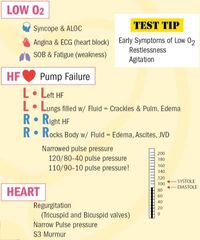
|
All problems lead to LESS cardiac output meaning LESS O2-rich blood OUT to the body. • Low oxygen • Restlessness, agitation, altered LOC • syncope, dizzy + fatigue • Heart failure signs • Left-sided = Lung fluid • Right-sided = Rocks the body with fluid (edema, ascites, JVD) |
|
|
potassium foods |
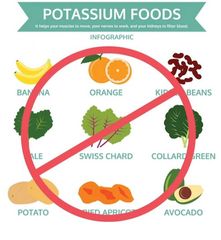
|
|
|
|
Peripheral Vascular Disease diagnostics |

|
|
|
|
DVT signs & symptoms |
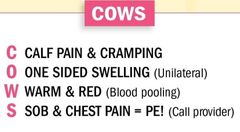
Avoid Humans Sign which can dislodge clot |
|

